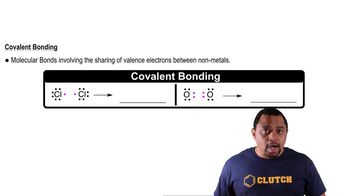The following three Lewis structures can be drawn for N2O:
(a) Using formal charges, which of these three resonance forms is likely to be the most important?
 Verified step by step guidance
Verified step by step guidance



The following three Lewis structures can be drawn for N2O:
(a) Using formal charges, which of these three resonance forms is likely to be the most important?
The following three Lewis structures can be drawn for N2O:
(b) The N—N bond length in N2O is 1.12 Å, slightly longer than a typical N ≡N bond; and the N— O bond length is 1.19 Å, slightly shorter than a typical N ═O bond (see Table 8.4). Based on these data, which resonance structure best represents N2O?
Ortho-Dichlorobenzene, C6H4Cl2, is obtained when two of the adjacent hydrogen atoms in benzene are replaced with Cl atoms. A skeleton of the molecule is shown here. (b) Are there any resonance structures for the molecule? If so, sketch them.
Consider the hypothetical molecule B-A=B. Are the following statements true or false? (a) This molecule cannot exist. (b) If resonance was important, the molecule would have identical A–B bond lengths.
An important reaction for the conversion of natural gas to other useful hydrocarbons is the conversion of methane to ethane. 2 CH4(g) → C2H6(g) + H2(g) In practice, this reaction is carried out in the presence of oxygen, which converts the hydrogen produced into water. 2 CH4(g) + 12 O2(g) → C2H6(g) + H2O(g) Use Table 8.3 to estimate H for these two reactions. Why is the conversion of methane to ethane more favorable when oxygen is used? Why is the conversion of methane to ethane more favorable when oxygen is used?